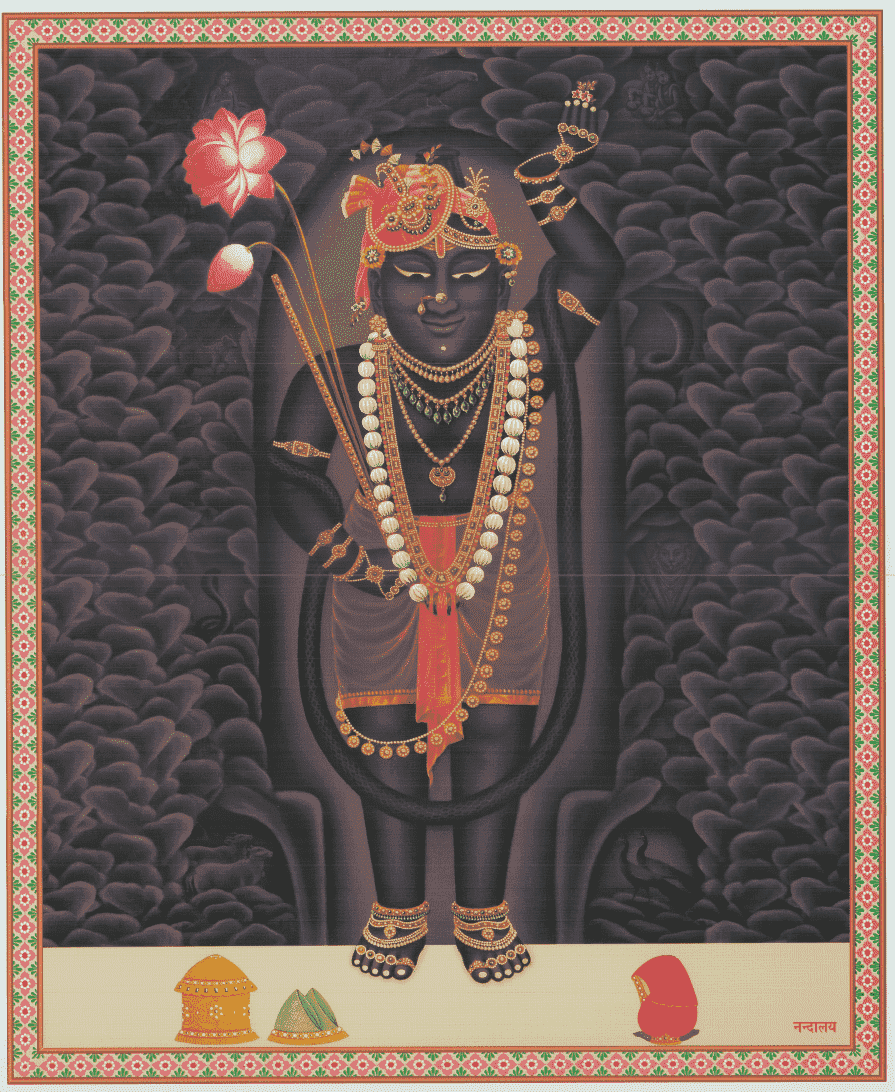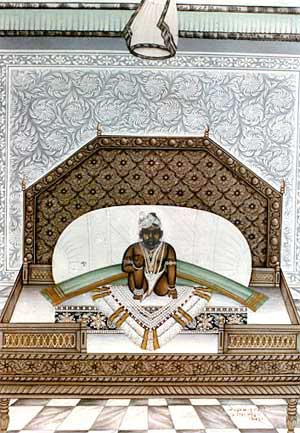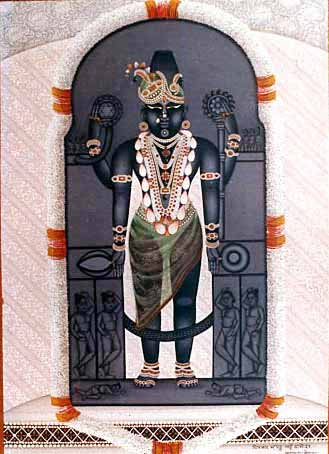Nidhi Swaroop
What is a Nidhi Swaroop?
The Supreme element is decribed as ‘Par-Brahman' in Vedas. Upnishads term HIM as ‘Parmatman'. Shreemad Bhagwat and other puranas, call HIM Bhagwan. As Brahman is 'Virrudh-Dharmashrayi', Brahman has Aprakru Anand Aakaar i.e. HE is Saakar for Bhaktas and also 'Niraakar'. He often bears a definite form, becomes ‘Sakar; and gives HIS glimpses to HIS ‘Bhaktas' in that form. Some times, though HE assumes HIMSELF like human, HE does not consist of Panch Mahabhoot Tatvas (elements) viz.Prithvi,Jal, Vayu, Tej and Aakash. But HE consistes of Anand (Bliss) only.In these forms HE is known as SWAROOP which are described in Upnishads as 'KRUSHNA', who took birth in VRAJ in Saraswat Kalp, and performed various ‘lilas'.These different swaroops assumed by ‘Krishna' to perform verious ‘lilas' have been accepted by Shri Vallabhacharyaji for performing HIS seva and they are known as NIDHI SWAROOPS in Pushti Sampraday which are as follows:
References:
Bhavbhavna of Shree Dwarkeshji (Bhavnaware)
Shreenathji Pithikabhavna by Shree Hariraiji and Shree Gopeshwarji
Shree Govardhannathji (Shree ShreeNathji)/Shree Gopalji:

“Ukshipt Hastah Purusho Bhakta Maakaratyutah || Dakshinen Karenaso Mustikrutya Manansi Nah|| Vaamam Karam Samudratya Nihyanute Pashya Chaaturim||”
Prakatya: Shree Girirajji (Goverdhan)
Patotsav: Maha Vad 7
Sevya Swaroop: Shree Mahaprabhuji
First Seva done by Vaishnav: Ramdas
Mukhya Dwar: Anyor
Presently Birajman: At Nathdwara - Rajasthan
Shreenathji’s left arm is raised to summon all his Nij Bhaktas. Shreenathji is standing on the Nikunja (Bower’s) Dwar. ShreeNathji’s right arm lowered and palm is fisted showing only the thumb indicating that Shreenathji has attracted the mind of all Bhaktas into him. Stele (Pithika) is rectangular. Amongst the Pancha Drishtis, Shreenathji ‘s Drishti is ‘Sanmukh Drishti’. Venunaad is of 5 types. Pancha Drishtis are given below:
- Sanmukh Drishti (Shreenathji) – Ras daan for Sarva Chetan Shrishti
- Vaam Paravrut – Ras daan for Dev Stris
- Dakshin Paravrut (Shree Gokulchandramaji)- Ras daan for Stris and Purushas
- Udho Drishti – Ras daan for Devanganas
- Adho Drishti-Ras daan for Devanganas
Shreenathji is Purna Purushottam Lord Shree Krishna himself. Shreemad Bhagwat describes the 10 types of Leelas of Shreenathji himself. Thus, Shreemad Bhagwat Mahapuran is the Vangmay Swaroop of Lord Shreenathji. 12 Mukhya Angas of Lord Shreenathji is the 12 Cantos of Shreemad Bhagwat Mahapuran. Thus, Shreenathji is swaroopatmak and Shreemad Bhagwat is Naamleelatmak.
| Shreenathji’s Mukhya Ang | Corresponding Shreemad Skandh | Leela |
|---|---|---|
| Both Charanarvindas | First and Second Skandh | Adhikar Leela |
| Both Arms | Third and Fourth Skandh | Sarga and Visarga Leela |
| Both Thighs | Fifth and Sixth Skandh | Sthaan and Poshan Leela |
| Right hand | Seventh Skandh | Uti Leela |
| Chest Region | Eighth and Ninth Skandh | Manvantar and Isanukatha Leela |
| Heart | Tenth Skandh | Nirodh Leela |
| Head | Eleventh Skandh | Mukti Leela |
| Left hand | Twelfth Skandh | Ashray Leela |
| Pithika Chinha | Bhav | Skandh Bhav |
|---|---|---|
| Parrot – Shree Shuk | Bhagwatarth,Skandharth,Adhyayarth,Prakaranarth,Vakyaarth,Padarth,Akshararth of Shreemad Bhagwat Mahapuran. Reminds the story of Second Skandh when Shree Shukdevji arrives and starts the katha of Bhagwat Mahapuran and in this way does the daan of Prem Lakshana BHakti to King Parikshit. Thus parrot is located at Shree Mastak of Shree Prabhu symbolizing that Shree Prabhu always keeps the Guru who gives daan of his Bhakti, on his Shree Mastak. | Second Skandh and Tenth Skandh |
| Both Cows | The conversation between Prithvi and Dharm | First Skandh |
| Naag | Reminds the story of King Parikshit getting the curse from Shrungi Rishi to get bitten by Takshak Naag. Also Symbolizes the Samudra Manthan of 8th Skandh. Samudra Manthan is not possible without the Rop and Vasuki Naag became the rop during Samudra Manthan. Thus this also symbolizes the Manvantar leela which describes the Dharmas of bhakt jeevas. Kaliyanaag Uddhar Leela of Tenth Skandh | First Skandh ,eigth Skandh and Tenth Skandh |
| Muni | This Muni is on the Right side. This Muni symbolizes the Sankhya-Acharya Shree Kapil Muni who preached mother devhuti Sankhya Shastra. | Third Skandh |
| Two Munis | Two Munis are located on the Left side. These 2 munis symbolizes Nar-Narayana. | Fourth Skandh |
| Cow | This is the swaroop of Prithvi which is the swaroop of Kamdhenu which is capable of completing any type of wish. Symbolizes King Pruthu who did the Dohan of Prithvi. Also symbolizes the Anugrah of Shree Prabhu i.e. Poshan Leela. Arishtasur Uddhar leela of Tenth Skandh | Fourth Skandh , Sixth Skandh and Tenth Skandh |
| Mountain | This is located near the Charanarvind of Shreeji. This symbolizes the prithvi of Swetvaraha Kalp of Adi Brahm Kalp. This Prithvi is made pure by the touch of Shree Charanarvind of Shreeji. Also symbolizes Shree Girirajji, below whom, Bhaktas gets the Sharanagati of shree Prabhu. Thus mountain lies below the Lotus like feet of Shreeji. | Fifth Skandh |
| Goat | This symbolizes the Kaal Chakra. Goat is known as ‘Vrushabh’ in Sanskrit. And Kaal Chakra starts from ‘Vrushabh’ Rashi. Vyomasur Uddhar leela of Tenth Skandh | Fifth Skandh and Tenth Skandh |
| Narsimh | Symbolizes Uti leela. Shree Narsimh Avatar is the Bhakt – Uddharak Avatar and destroyed the A-Sat Vasana by killing demon Hiranyakasyapu. Kaustubh Mani Avtar. | Seventh Skandh and Tenth Skandh |
| Peacock couple | Peacock couple symbolizes the Nirupadhik (Selfless Love). Thus this symbolizes the Selfless Love of Bhaktas towards Shree Prabhu and the leela of this is described in Isanukatha Leela | Ninth Skandh |
| Two Snakes | Symbolizes that when jeev gets rid of his Ahanta and Mamta then only jeeva can understand swaroop of Shreeji. | Eleventh Skandh |
| ALL Three Rishis | Symbolizes the three types of AShray i.e. Adhi-Bhautik Ashray, Adhyatmik Ashray and Adhidaivik Ashray. | Twelfth Skandh |
Shree Dwarkeshji (Bhavnaware) has composed a kirtan describing the bhavna of Shree Shreenathji. Below is the Kirtan:
Dekhyori Mein Shyam Swaroop|
Vaambhooja Unche Kar Giridhar, Dakshin Kar Kati Dharat Anoop||
Mushtika Bandh Angust Dikhavat, Sanmukh Drisht Suhaayi|
Charan Kamal Yugal sam Dhare, Kunj Dwar Man Bhayi||
Ati Rahasya Nikunj Ki Leela, Hriday Sumiran Kije|
'Dwarkesh' Man Vachan Agochar, Charan Kamal Chitta Dije ||
Shree Navnitpriyaji:

Jaanitam Paramam Tatvam, YashodotsangLaalitam||Tadanyaditi Ye Prahurasuranstaanaho Budhaha||
Prakatya: Shree Yamunaji (Mahavan)
Patotsav: Posh Vad 6
Sevya Swaroop: Shree Mahaprabhuji
First Seva by Vaishnav: Gajjan Dhavan
Mukhya Dwar: Surabhi Kund
Presently Birajman: At Nathdwara - Rajasthan
Shree Navnitpriyaji appeared from Shree Yamunaji (Mahavan). The swaroop was found by one of the sevaks of Shree Mahaprabhuji i.e. Mahavan Kshtrani from Mahavan. Kshatrani took this swaroop to Shree Mahaprabhuji. At that time, Gajjan Dhavan was sitting besides Shree Mahaprabhuji. Seeing this swaroop, Gajjan Dhavan requested Shree Mahaprabhuji to give permission to do seva of lalan. Afterwards, Gajjan dhavan did seva of Shree Navnitpriyaji for many years and then when Gajjan Dhavan was incapable to do seva, he gave this swaroop back to Shree Mahaprabhuji. Afterwards, Shree Gusaiji did seva. Shree Navnitpriyaji was Shree Gusaiji's Nij Thakurji. Shree Navnitpriyaji since then remained in the family of Shree Mahaprabhuji only. After Shree Gusaiji, First son of Shree Gusaiji, Shree Giridharji did seva of Shree Navnitpriyaji and thus, Shree Navnitpriyaji is the Nij thakurji of Pradhan Gruh.
This swaroop is of Balleela. Other leelas are gupt. Shreemad Bhagwat Tenth Canto 8th Adhyay Praman Prakaran Ringan Leela is pragat in this swaroop. Infact, entire Tamas Prakaran is pragat in this swaroop. other Leelas are gupt. Shree Navnitpriyaji is fair in color (Gaur Varna). Shree Navnitpriyaji's eyes are 'Sanjan' i.e. Mascara. One hand is resting on floor and the other one is holding 'Navnit' i.e. Butter ball. Shree Charanarvindas are in the position of crawling (Ringan). Below is the kirtan describing the swaroop bhavna of Shree Navnitpriyaji composed by Shree Kaka Vallabhji:
Le Ju Gayo Chitta Maakhan Pyaaro|
Tanak Kamal Mukh dwe Datiya, Ina Aankhan Te Hot Na Nyaaro||
Ringan Leela Bhav Janavat, Maryada Rahit Yah Roop|
Kati Kinkini Aur Paav Penjani, Phiri Chitavan Hast Bajat Anoop||
Dekh Sankhi Lapate Bhuj Bhidata, Nakh Kshat Kuch Kapol Kar Parasata|
Kahat Phirata Sabaso Nandrani, Dekh Bhaiya Bavaro Vhe Darasata||
Shree Mathureshji:

Mathuranayakam ShreematsakansaChaanurmardanam| DevakiParamanandam Tvamaham Sharanam Gatah||
Priya Bhujaslistabhujaha KankanakrutiChakrakaha | KambuKanthodDhrutBHuje LeelaKamalVetraDhruk||
Pragatya: From Karnawal on the banks of Shree Yamunaji
Patotsav: Fagan sud 7
Sevya Swaroop: Shree Mahaprabhuji
First Seva by Vaishnav: Padhmanabhdasji
Tamas Pramey Prakaran First Adhyay Leela is pragat in this swaroop. Other leelas are gupt. Shree Nandrajkumar is Dwibhooj in Vraj but this swaroop of Shree Nandraj kumar is 'Chaturbhooj' i.e. Four armed. Shree Nandraj kumar is four armed for four main reasons:
- Swa-Anand daan
- To remove obstacles in relishing Swa-Ananda
- To enable Vrajbhaktas to do his seva i.e. Swa-Seva Swikar
- To invoke different Bhavas in Vrajbhaktas by his divine sports invoking 14 different Rasas during Go-charan and arriving to Vraj after Go-charan.
The shlok describing the swaroop of Shree Mathureshji is given below:
"Tam GorajchhuritaKuntal Baddha Barha... " of Shreemad Bhagwat 10-14-42.
The fourteen Rasas invoked by Shree Mathureshji are given below:
Dharma, Arth, Kaam, Moksha Purusharthas and other 10 Rasas named Vir, adbhut,Bhayanak,Hasya,Karun,Shringar,Raudra,Bibhatsa, Shanta and Bhakti. The swaroop that invokes four main bhavas i.e. Dasya,Vatsalya,Sakhya and Madhurya is called 'Chaturbhuj'. THe arms of Shree Prabhu is 'KRiya Shakti' and thus the above 4 Kriya Shaktis are pragat in Shree Mathureshji.
Shree Mathureshji is holding Shankh (conch), Chakra (discus), Gada (Mace), and Padma (Lotus) in sequence in his four arms starting from lower left arm. Thus according to the 'Ayudh Kram' (Sequence of holding ayudhas), Shree Mathureshji is 'Madhusudana'. Since, Shree Mathureshji destroyes the 'Laukik Mada' and installs 'alaukik Ras mada' in bhaktas, he is 'Madhusudana'. Thus Shree Mathureshji does the 'Gajavat Vihar Leela' . Below is the bhav of four different 'Ayudhas' :
- Shankh (Conch): Shree Swaminiji's Kanth (Shree Yamunaji)
- Padma (Lotus): Shree Swaminiji's Mukharvind (Shree Radhaji)
- Gadha (Mace): Shree Swaminiji's Arm( Shree Kumarika - Shree Radha Sahchariji)
- Chakra (Discus): Shree Swaminiji's Bangals.(Shree Chandravaliji)